A linear antenna has the same gain receiving or transmitting. Likewise, the path loss is the same in either direction. This property is called reciprocity.
However, most but not all antennas are linear. Some may have losses that increase non-linearly with increasing power. For example, the loopstick antenna is a small loop antenna made of many turns of fine wire around a ferrite rod. The ferrite rod helps concentrate the magnetic flux through the loop, giving the antenna an effective aperture much larger than its physical size. However, the ferrite saturates at even modest transmit powers. Reciprocity does not hold.
It's also likewise possible to construct a propagation medium in which reciprocity does not hold, but it requires a non-linear material. Since most propagation occurs in air which is quite linear, this is more a theoretical problem than a practical one.
However, the path and the antenna are not the whole system. There are practical issues that make wireless communication links not symmetrical, meaning if A can hear B, B may not hear A. It's not an uncommon case for one station to have a higher power transmitter, especially when one of the devices is battery powered (cell phones, Wi-Fi, ...). The receivers or transmitters on either end may likewise not have identical sensitivity or selectivity.
Furthermore, the different location of each station can lead to asymmetric communications. The hidden node problem you mention is one case. It can also be that there is a source of noise that's close to A, but far from B. In this case, B may hear A, but A may not hear B due to the higher noise floor in A's location. Related is the exposed node problem.
These issues of asymmetric link quality are very significant in the design of wireless communications in practice. A common solution is to have the station with the likely biggest, tallest, highest power antenna arbitrate access to the medium. Cellular networks take this approach: the tower tells the phones when they may transmit. Cellular towers also have wired links to each other to further improve their cooperation. It's a much more difficult problem when a central authority does not exist. See for example version two of B.A.T.M.A.N. which was developed primarily to address this problem in its mesh protocol.
